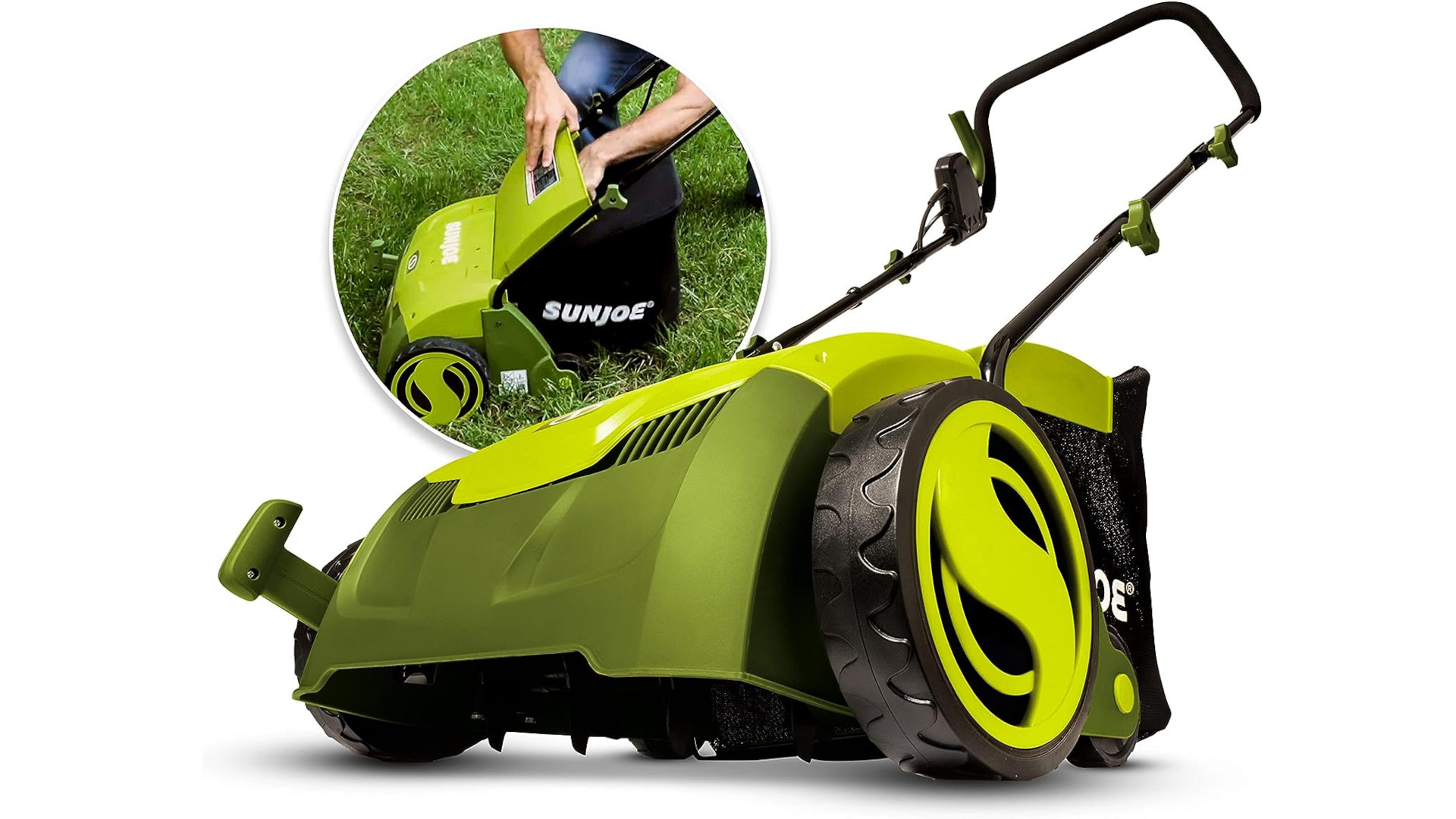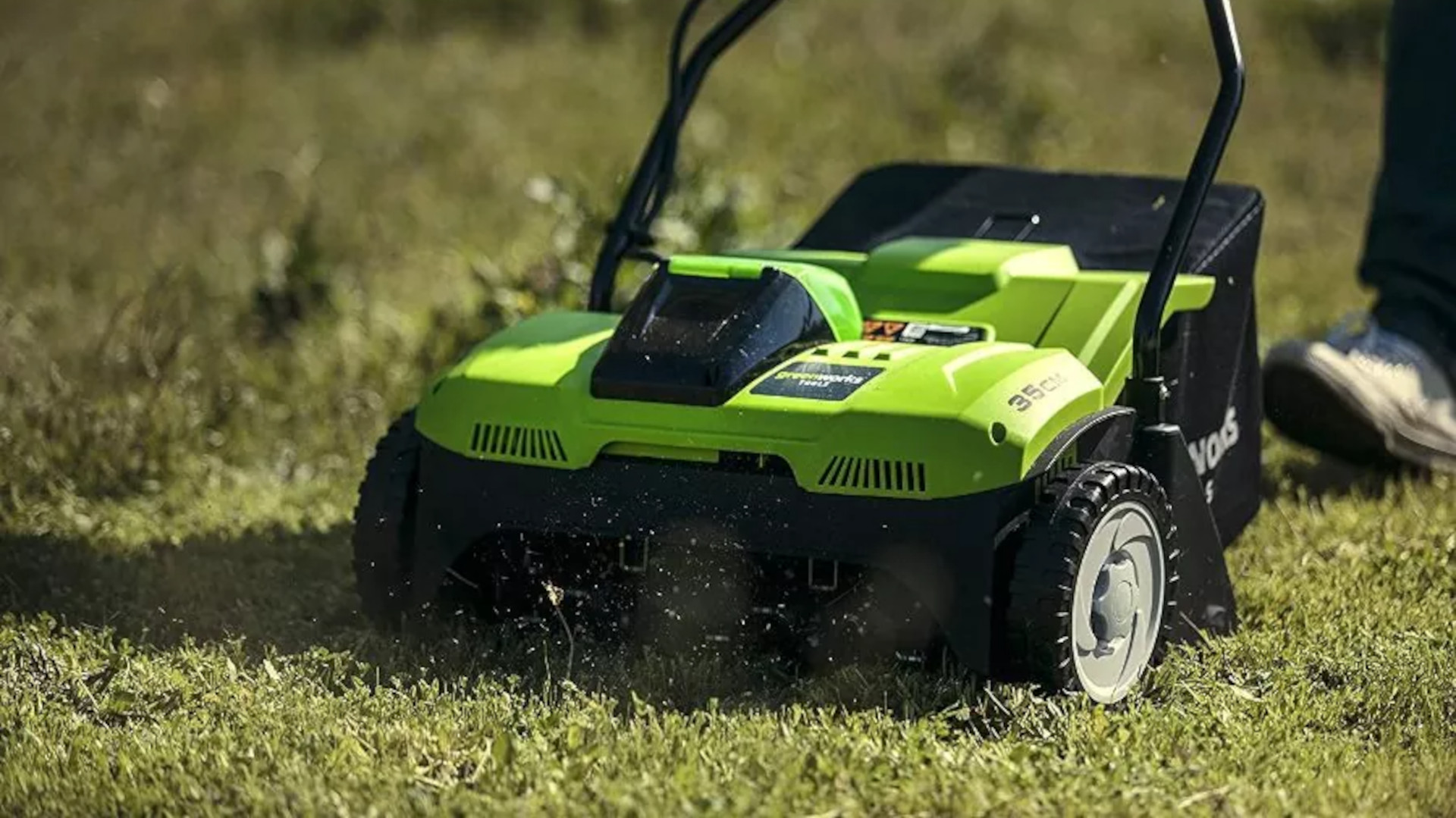Scarifier vs dethatcher: experts explain the difference
All the key differences to help you understand which process is better for your lawn

Power: Mains electric 15 amp, 3300 rpm
Effective width: 16-inches
Uses: Dethatching and scarifying
Positions: 5, from +1/4 inch to -1/2 inch depth
This WEN DT1516 Dethacher is a mains powered model which offers a power 15 amp setup to get a 3300 rpm drive. That means the 24 teeth, which span 16-inches, to give a wide cutting area for faster coverage of your lawn space.
Usefully this also has scarifying teeth, should you wish to change between the two as you need. That means control over sensitivity but also depth thanks to five positions ranging from plus a quarter inch to minus half an inch in depth. Plus there's a collection bag to make the job even easier.
Pros
- 2-in-1 design
- Main powered
- Wide 16-inch path
Cons
- Need mains power
- Not the cheapest

Power: Mains electric 12 amp, 2990 rpm
Effective width: 13-inches
Uses: Dethatching and scarifying
Positions: 5
The Sun Joe AJ801E Scarifier offers a decent amount of power from the 12-amp motor than spins up to 2,990 rpm at full speed. This offers 20 slicing blades which run up to an effective working width of 13-inches making it ideal for smaller yard spaces as well as larger lawn areas.
This comes with a dethatching head also allowing you to work more gently with your lawn space as needed. There is also an 8-gallon collection bag to make quick work of not only pulling out but also clearing of the dead grass layer.
Pros
- Ideal for smaller spaces
- 2-in-one design
- Decent catch bag
Cons
- Lower speed than some
- Not ideal for larger lawns
Scarifying and dethatching can both provide excellent results in lawn health and appearance, but it's important to know the difference between each tool so that you don't cause more harm than good.
While they both essentially remove debris from the lawn, there are some key design and performance differences that can affect the impact that it has in your backyard. A common misconception is that the machines are large, heavy and bulky, but the process of scarifying and / or dethatching can easily be carried out at home whilst fixing patchy grass with more portable, manoeuvrable machines.
We've caught up with a few lawn care experts to help you determine which tool is best for the job. It may seem like a brutal task but, carried out correctly, a scarifier or dethatcher could yield greener, healthier grass when spring arrives.
What's the difference?
Let's start by asking what is a dethatcher and what is a scarifier so that we can determine the differences and make sure your lawn is kept safe.
Physically, a scarifier uses hooked spikes to scar the earth and pull up the thatch whereas a dethatcher uses thin straight spikes to pull out thatch without as much grass damage in the process.
We spoke to gardening expert Adam Woolcott about the differences between the two. "Dethatching is the gentler of the two processes removing moss, dead grass and weeds as well as other detritus from the lawn using metal tines, possibly down to but not below ground level," he explains.
"This opens the grass up to the air and light, allows the rain to penetrate and encourages fresh, healthy grass to grow back without the smothering effects of everything it was competing with previously."
Sign up to receive the latest news, reviews, buying guides and deals direct to your inbox
The key difference comes down to the length of the spikes and the impact on your lawn: "Scarifying does the same as above but to a much greater extreme with blades that actually penetrate and cut into the soil leaving slits in the earth."

Adam, a Vlog/blogger For Webb, has over 30 years of experience as a professional gardener and has many accolades but is probably best known for his four Gold Medals at The Royal Horticultural Society’s Chelsea Flower Show in London (UK) and his three BBC/RHS People’s Choice Awards at the show (of which he is particularly proud) which he won as one half of Woolcott & Smith.
John Parker, general contractor and founder of Easy Pool Cleaning, adds that "scarifiers don't just remove the thatch; they dig deeper, taking out debris and aerating the soil."
"Dethatchers are milder and more focused," Parker explains. "They remove the thatch layer without delving too deep, leaving some thatch behind." Post-treatment, grass tends to recover faster after dethatching as compared to scarifying.

John Parker is a general contractor, a pool cleaning expert, and the founder of Easy Pool Cleaning. He spent 10 years as a general contractor before starting a successful pool cleaning business. Soon after, he expanded the scope of my services to include all manner of backyard improvement and maintenance, as well as landscaping.

Why use them?
Overtime, the lawn can build up a layer of thatch from dead grass and natural debris – a layer sitting between the grass top and the roots below. This can be useful as a way to help trap moisture and renew your soil by composting, but once this reaches more than half an inch it can start to suffocate the grass by cutting off nutrients and stopping water flow to the soil.
Sally Allsop, owner of gardening blog All That Grows, explains why you should use these tools to promote a healthier lawn.
"A scarifier is used to aerate a lawn. It's designed to help water, air and nutrients reach down to the root of the soil and cut through weeds," she explains. This is done using metal spikes that dig into the soil, reducing soil compaction and encouraging new grass growth.
A dethatcher, on the other hand, is the softer approach as it doesn't go below ground. "A dethatcher is used to remove thatch from the surface," Sally adds. It doesn't dig into the soil in the way that a scarifier would, but it helps to remove dead grass, roots, and other build-up on the surface of the soil.

Sally Allsop is an avid gardener and founder of the online gardening site All That Grows. All That Grows is an inspirational gardening blog, covering growing fruit, vegetables and flowers. On the site, you’ll find many useful hints and tips to help you get the most out of your garden, plus other DIY garden projects.
Which is best?
Whether you pick a scarifier or dethatcher largely depends on the state of your lawn. Dethatching is far more gentle for well established or young lawns, whereas a scarifier is great for a fresh start or for a deeply built up lawn that needs a tough touch.
If you already have a ride-on lawn mower then a pull-behind attachment is a great option. As scarifiers can be quite heavy duty, you may find there are more dethatcher options available, like this dethatcher attachment from Brinly-Hardy.
Garden and landscaping expert Tom Su (and owner of Lawn Edging) explains when you should choose a dethatcher or scarifier. "Dethatchers are more about surface-level cleanup, removing that layer of organic debris. Scarifiers go deeper to relieve soil compaction and promote better grass root health."
He adds that "dethatching might be needed more often, especially if you have fast-growing grass types or use a lot of fertilizers. Scarifying can be more of an occasional treatment, depending on your lawn's needs."
As scarifying is a much more brutal process, it can be best to save it for when a lawn is in need of a major clean up. Unlike dethatching, it digs deep into the soil, taking out unwanted debris and aerating the soil. Dethatching may be best if your lawn needs a quicker, gentler revival.

Tom Su is the visionary behind Lawn Edging, a brand synonymous with innovative and sustainable garden design solutions. Tom has over a decade of experience in the home and garden industry. He has dedicated his career to creating beautiful, sustainable outdoor spaces. As the owner of Lawn Edging, he specializes in high-quality lawn edging solutions that enhance the aesthetic and functional value of any garden.
FAQs
When should you scarify a lawn?
In most parts of the US, scarifying in spring or early fall is generally recommended. Scarifying at other times of year may limit regrowth, leaving the lawn thin and patchy for a long period.
With that said, some experts argue that scarification shouldn’t be done at all, as it may harm the lawn more than it helps it. The scarification process inevitably does short-term damage to the lawn, and it may also decrease the lawn’s biodiversity. Think carefully about when to scarify your lawn – and if you go ahead, scarify at a time when the grasses will get a warm-weather window of time for regrowth, immediately after scarification.
When should you dethatch a lawn?
The best time of year to use a dethatcher will vary depending on your local climate. Basically, it’s better to dethatch at a mild or warm time of year when the grass can regrow quickly.
Another determiner is the type of grass: specifically, whether your lawn is made up of cold season grasses or warm season grasses. Cold season grasses are best dethatched during late summer or early fall, while warm season grasses should ideally be dethatched in late spring or summer.
Most expert sources agree that you should avoid using a dethatcher on your lawn outside of its growing season, or at times when the grass is stressed due to an issue such as excessive heat or dehydration.
How can I care for and maintain a scarifier?
Generally, the most important thing is to keep your scarifier clean. Soil, dirt and debris can build up on both the cutting tools and the anchor points, so it helps to use a damp cloth and a metal-safe cleaning solution, like this Resinate Green Cleaning Solution, to wipe down the cutting equipment. Any remaining dirt can be cleaned up with an elongated brush.
If yours is a gas model, it's worth checking your spark plug to make sure there are no difficulties when starting the engine. It's also important to check the oil level and remove any dried oil residue.
Luke is a veteran tech journalist with decades of experience covering everything from TVs, power tools, science and health tech to VPNs, space, gaming and cars. You may recognize him from appearances on plenty of news channels or have read his words which have been published in most tech titles over the years. In his spare time (of which he has little as a father of two) Luke likes yoga, surfing, meditation, DIY and consuming all the books, comics and movies he can find.

